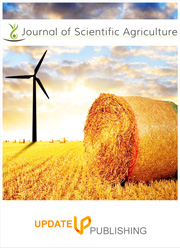Genotype X environment interaction analysis on dry biomass yield of late maturing fodder oat (Avena sativa L.) genotypes in mid and highland areas of West Arsi and Bale, South East Ethiopia
DOI:
https://doi.org/10.25081/jsa.2025.v9.9473Keywords:
Fodder oat, Genotypes, Biomass yield, Bona-bass, QualityAbstract
Eleven genotypes of fodder Oat (Avena sativa L.) were evaluated across four locations with one standard checks Bona-bas under rainfall conditions from 2022 to 2023. Both agronomic and chemical composition data were collected. The analysis of the data indicated a statistically significant difference(P<0.05) between genotypes in the days of 50% heading, plant height, biomass yield, date to seed maturity, thousand kernel weight and seed yield. The overall mean of Biomass yield (15.8 ton ha-1) and Seed yield (29.3 quint ha-1). Quality parameters such as ash, crude protein(CP), neutral detergent fiber (NDF), acid detergent fiber (ADF), acid detergent lignin (ADL) and dry matter content is not significantly different (P>0.05) between genotypes. The additive main effects and multiplicative interaction (AMMI) analysis of the dry Biomass yield indicated significant influence by genotype, Environment and year interaction. Among the Eleven genotypes and Bona-bass standard check evaluated in the trial the ILRI #5427 and ILRI #5524 has indicated higher biomass yield and Better stability were selected for variety registration and further promotion.
Downloads
References
AOAC. (1990). Official methods of analysis. (15th ed.). Washington, US: Association of Official Analytical Chemist.
Befekadu, C., & Yunus, A. (2015). Evaluation of biomass yield and growth performance of alfalfa and oat cultivars in the high land of Arsi, Ethiopia. Livestock Research for Rural Development, 27(6), 114.
Ceccarelli, S., Grando, S., & Booth, R. H. (1995). International breeding programmes and resource-poor farmers: crop improvement in difficult environments. In P. Eyzaguirre & M. Iwanaga (Eds.), Workshop on Participatory Plant Breeding Wageningen, Netherlands: IPGRI.
Dawit, A., & Mulusew, F. (2014). Performance of fodder oat (Avena sativa L.) genotypes for yield and yield attributes in the Highland of bale. Proceedings of the Ethiopian Society of Animal Production: Theme of Private Sector in the Ethiopian Livestock Industry (pp. 59-65). Investment Opportunities and Challenges Proceeding.
Dawit, A., & Teklu, W. (2011). Registration of Bonsa and Bona-bas fodder oats varieties for the Bale highlands, Ethiopia. East African Journal of Sciences, 5(2), 131-133.
Gadisa, B., Debela, M., Dinkale, T., & Tulu, A. (2023). Forage yield and quality parameters of eight oat (Avena sativa L.) genotypes at multilocation trials in Eastern Oromia, Ethiopia. Cogent Food & Agriculture, 9(1), 2259521. https://doi.org/10.1080/23311932.2023.2259521
Kebede, G., Faji, M., Feyisso, F., Mohammed, K., Assefa, G., Geleti, D., Minta, M., Dejene, M., Alemayehu, M., Mengistu, A., Tsegahun, A., & Mengistu, S. (2021). Yield and Nutritional quality of Oat (Avena sativa) genotypes under vertisols conditions in the central highlands of Ethiopia. Journal of Agriculture and Environmental Sciences, 6(2), 1-16.
Mesgana, F., Melle, T., Zina, D., Ermias, A., Molla, M., Gebremariam, A., Mequanint, A., Fentanesh, S., Desalegn, G., Yasin, T., & Sefinew, W. (2020). Adaptation of Food oat (Avena sativa L.) genotypes in Amhara region, Ethiopia. East Africa Journal of Science, 14(2), 111-120.
Mosissa, F., Kefala, B., & Abeshu, Y. (2018). Potential of oats (Avena sativa) for food grain production with its special feature of soil acidity tolerance and nutritional quality in Central Highlands of Ethiopia. Advances in Crop Science and Technology, 6(4), 376. https://doi.org/10.4172/2329-8863.1000376
Nikkhah, H., Yousefi, A., Mortazavian, M., & Arazmjoo, M. (2007). Analysis of yield stability of barley (Hordeum vulgare L.) genotypes-using additive main effects and multiplicative interaction (AMMI) model. Iranian Journal of Crop Sciences, 9(1), 1-13.
Sharma, A., Sharma, G. D., Kumar, N., & Chahal, A. (2019). Studies on the performance of promising varieties of oat (Avena sativa L.) under different cutting regimes in mid-hill conditions of Himachal Pradesh. Journal of Pharmacognosy and Phytochemistry, 8(2), 728-731.
Van Soest, P. J., Robertson, J. B., & Lewis, B. A. (1991). Methods for dietary fiber, neutral detergent fiber, and nonstarch polysaccharides in relation to animal nutrition. Journal of Dairy Science, 74(10), 3583-3597. https://doi.org/10.se68/jds.s00220302(91)78551-2
Yan, W. (2011). GGE biplot vs. AMMI graphs for genotype-by-environment data analysis. Journal of the Indian Society of Agricultural Statistics, 65(2), 181-193.
Published
How to Cite
Issue
Section
Copyright (c) 2025 Aliyi Kedu, Gemechis Lencho, Wubshet Tesfaye, Teklu Wegi

This work is licensed under a Creative Commons Attribution-NonCommercial-NoDerivatives 4.0 International License.



 .
.